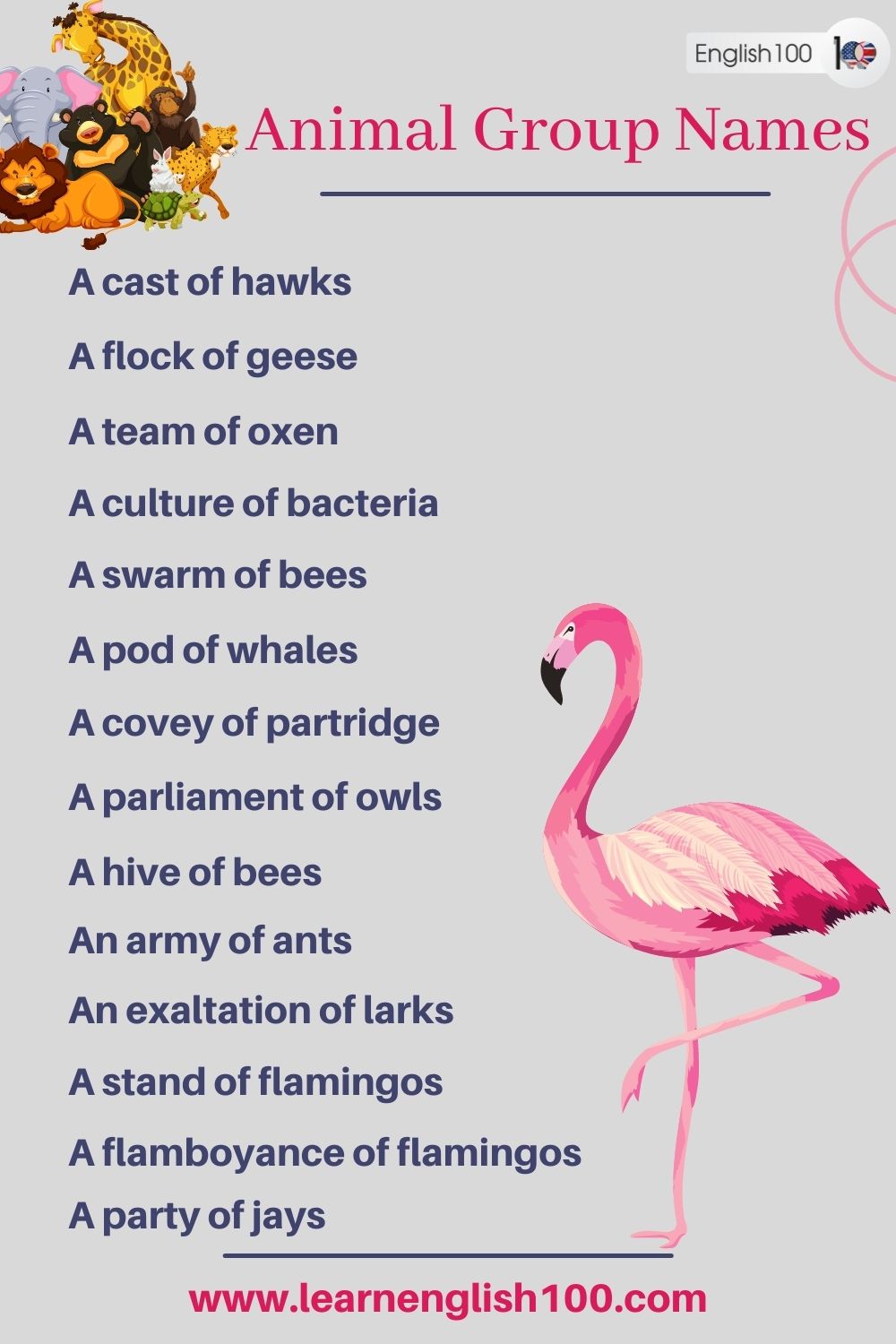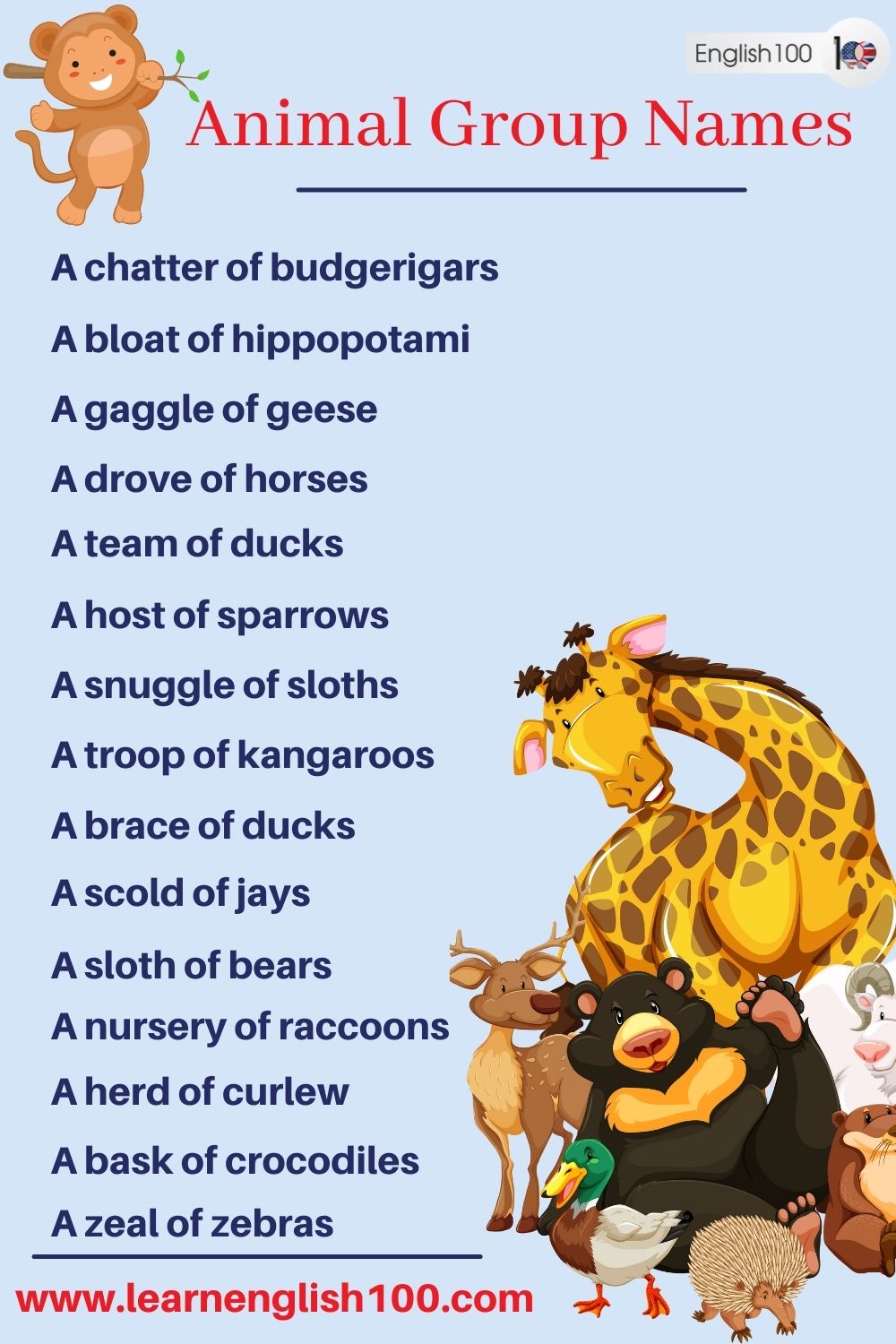



Animal Group Names
In the vast and diverse realm of the animal kingdom, many species exhibit remarkable social behaviors, often coming together in groups for various purposes. These gatherings are not just about survival; they also offer a glimpse into the intricate web of nature’s design. In this article, we will delve into the captivating world of animal group names, shedding light on the terminology that defines these unique collective behaviors.
Each of the animal groups has its own unique characteristics and behaviours, and they play important roles in the ecosystems they inhabit. 1
Just like every noun in the English language, animals’ have group nouns of their own. Let’s get to know them together:
A cast of hawks
A flock of geese
A team of oxen
A culture of bacteria
A swarm of bees
A pod of whales
A covey of partridge
A parliament of owls
A hive of bees
An army of ants
An exaltation of larks
A stand of flamingos
A flamboyance of flamingos
A party of jays
An army of frogs
A colony of badgers
A trip of goats
A tribe of goats
A herd of goats
A cackle of hyenas
A pack of wolves
A family of otters
A flight of birds
A cling of koalas
A trip of dotterel
A pride of lions
A pack of mules
A parade of elephants
A flock of sheep
A sedge of herons
A raft of penguins
A waddle of penguins
A shoal of fish
A smack of jellyfish
A troop of monkeys
A shrewdness of Apes
A haul of fish
An ambush of tigers
A streak of tigers
A bale of turtles
A flight of dragons
A zoo of wild animals
A crash of rhinoceros
A nest of turtles
A clowder of cats
A mustering of storks
A murder of crows
A drove of donkeys
A herd of camels
A string of horses
A mob of kangaroos
A leap of leopards
A pit of snakes
A den of snakes
A nest of snakes
A school of dolphins
A pod of dolphins
A wisp of snipe
A tower of giraffes
A school of whales
A flock of snipe
A nest of mice
A caravan of camels
A muster of peafowl
An ostentation of peafowl
A plague of locusts
A catch of fish
A scurry or dray
A colony of gulls
A stud of horses
A knot of toads
A litter of cubs
A mob of meerkats
A gang of meerkats
A mob of deer
A chatter of budgerigars
A bloat of hippopotami
A gaggle of geese
A drove of horses
A team of ducks
A host of sparrows
A snuggle of sloths
A troop of kangaroos
A brace of ducks
A scold of jays
A sloth of bears
A nursery of raccoons
A herd of curlew
A bask of crocodiles
A zeal of zebras
Most importantly, you have to pay attention to the similar group nouns and not misplace them or overgeneralize them. For instance, we have the words pride of lions and parade of elephants. Both words are pronounced similarly and written in an almost close manner in regard to the letters causing those particular sounds, phonetically speaking, which causes people to mishear and misuse one of the words on the account of the other which somehow disappears from use.
It is not advised for students to memorize this by heart, rather a continuous check from time to time according to how needed in their study.
Understanding Animal Groups
Before we dive into the intriguing names that describe these animal gatherings, it’s essential to grasp the concept of why animals form groups in the first place. While survival is undoubtedly a driving factor, the reasons behind group formation vary. Some animals come together to protect themselves from predators, while others do so to enhance their hunting abilities. Some groups are driven by the need for warmth and comfort, while others are motivated by reproduction and raising offspring.
Herd: The Iconic Gathering
One of the most recognized and widely used terms in the realm of animal collectives is “herd.” A herd typically consists of large mammals such as deer, elephants, and buffalo. These social gatherings serve multiple purposes, including protection against predators and the sharing of resources such as food and water. The concept of a herd emphasizes unity and cooperation in the face of adversity.
Pack: Predatory Cooperation
While a herd may suggest a sense of unity, a “pack” represents a more organized and coordinated collective behavior. Wolves, for instance, are known for their pack mentality. This social structure enhances their hunting efficiency and ensures the survival of the group. The term “pack” highlights the strategic and often predatory nature of these animal communities.
Flock: Avian Harmony
Birds are renowned for their mesmerizing aerial displays, often witnessed in flocks. The term “flock” encompasses gatherings of various bird species, from the elegance of a flock of swans on a serene lake to the breathtaking sight of migratory birds on the move. Flocks provide safety in numbers during migration, offer protection from predators, and enable communal roosting.
Pride: Majestic and Familial
The regal term “pride” is associated with lions, the iconic big cats of the African savannah. A lion pride typically comprises related females, their cubs, and a few resident males. This close-knit family structure emphasizes the importance of kinship and cooperative hunting in the wild. The name “pride” reflects the majestic and familial nature of these gatherings.
School: Beneath the Surface
In the depths of the ocean, a different kind of collective behavior can be observed. Fish, such as sardines and herring, form enormous groups known as “schools.” These tightly packed formations offer protection from predators, allow for efficient feeding, and enhance mating opportunities. The term “school” evokes images of synchronized movement and coordination beneath the water’s surface.
Colony: Builders of Civilization
While “colony” may evoke thoughts of human settlements, it is also used to describe gatherings of animals like ants and bees. These insects exhibit highly organized social structures, working together to build complex civilizations. The term “colony” emphasizes the cooperative effort involved in their intricate and often industrious lives.
FAQ
What is the collective name for animals?
The collective name for animals is “animal group names.” These terms are used to describe the various ways in which animals come together in groups, such as herds, packs, flocks, prides, schools, colonies, and more. When referring to these collective behaviors in the animal kingdom, using the term “animal group names” can help provide clarity and specificity in your discussions or content. You may like collective noun.
What is a flock group of animals?
A flock is a collective group of animals, typically birds, that come together and move as a cohesive unit. Flocks are often observed in various bird species and are known for their coordinated aerial movements. Birds within a flock may fly in close formation, create mesmerizing patterns in the sky, or travel together during migration.
Flocking behavior serves several purposes, including safety from predators, efficient foraging for food, and communal roosting for warmth and protection. Flocks can range in size from a few individuals to thousands or even millions, depending on the species. Some well-known examples of animals that exhibit flocking behavior include starlings, geese, and pigeons.
What is the coolest name of a group of animals?
The coolest name for a group of animals is often a matter of personal preference and can vary depending on individual interests. However, one of the intriguing and cool names for a group of animals is a “murmuration.”
A murmuration is used to describe a large flock of starlings (birds) when they perform their mesmerizing synchronized aerial displays, creating intricate and breathtaking patterns in the sky. The sight of a murmuration is not only visually stunning but also a testament to the beauty and complexity of nature.
To conclude, the world of animal group names is a captivating exploration of the diverse social behaviors observed in the animal kingdom. From the unity of a herd to the strategic coordination of a pack and the familial bonds of a pride, each collective term reflects the unique characteristics and survival strategies of different species. By delving into these names, we gain a deeper appreciation for the complexities of the natural world and the fascinating ways in which animals come together to thrive.
References:
- Mishra, S. (2023, January 4). Teach Kids: List of animals & their group names. Firstcry Intelli Education.
